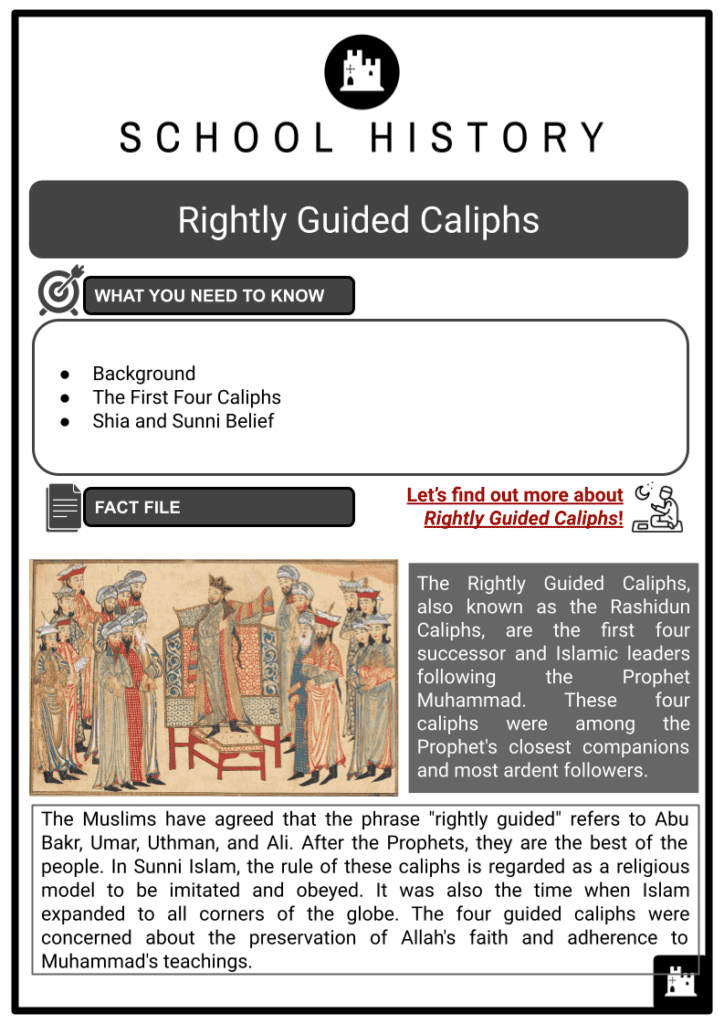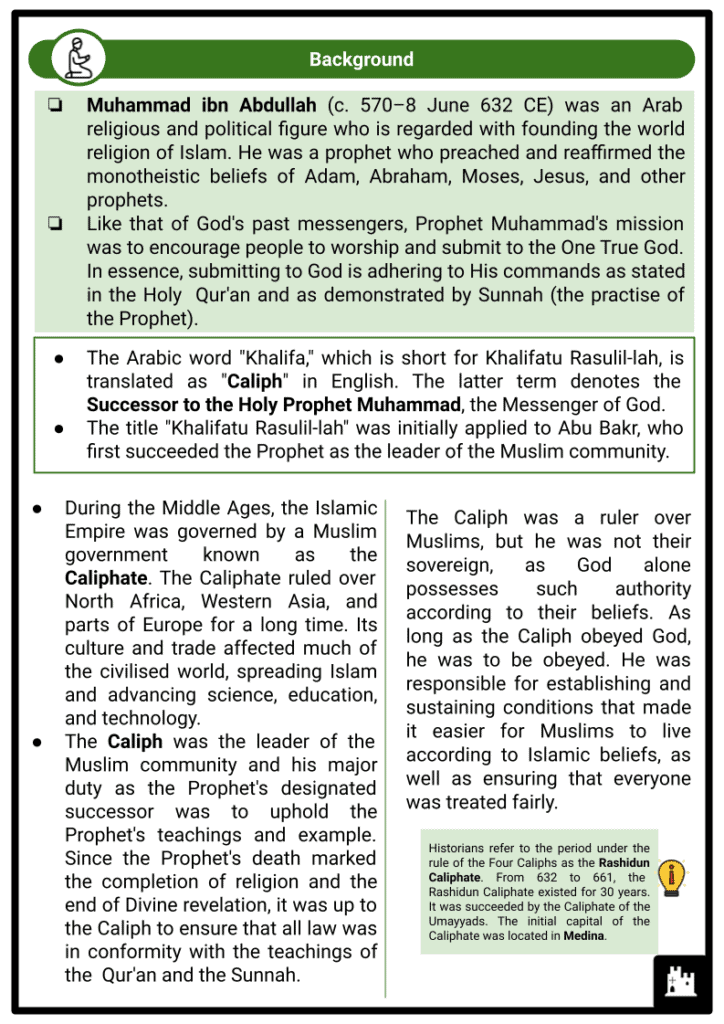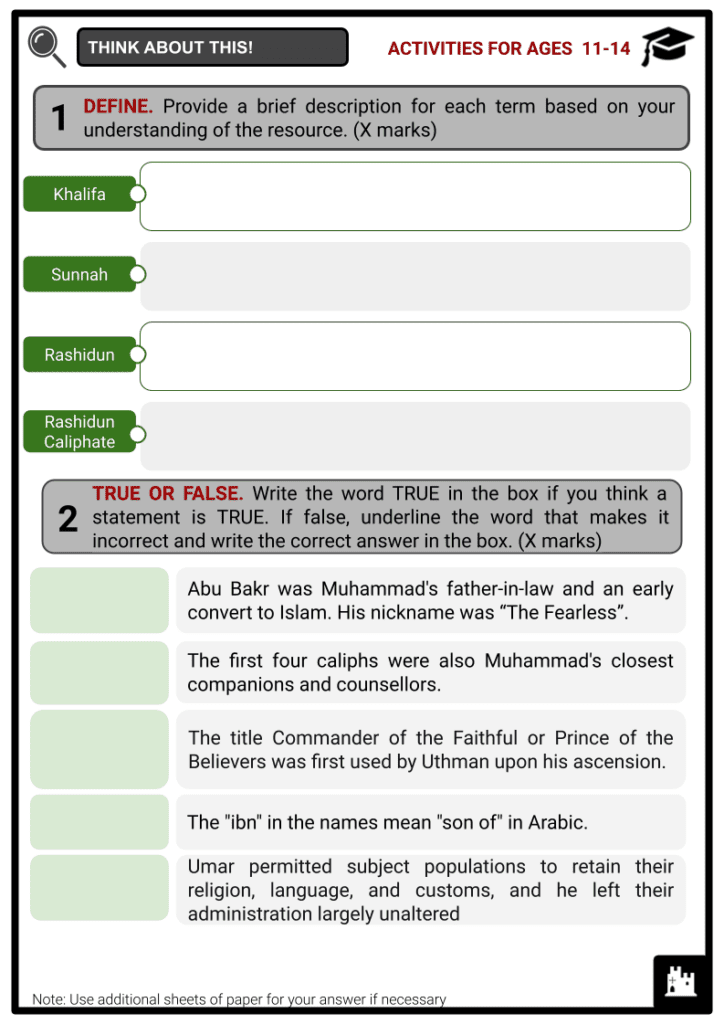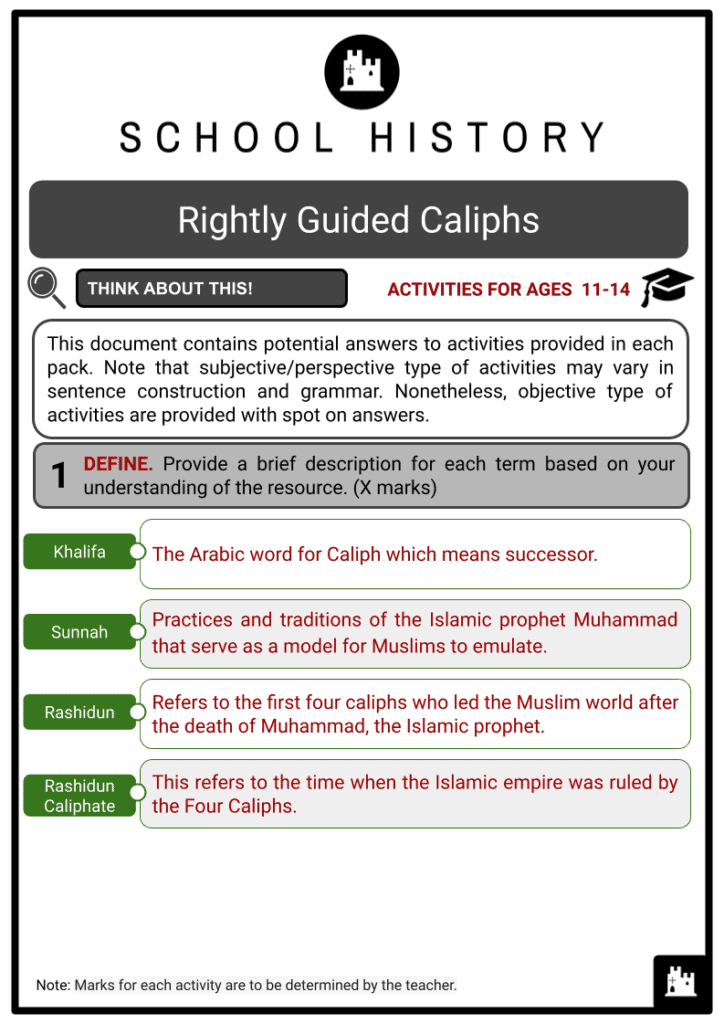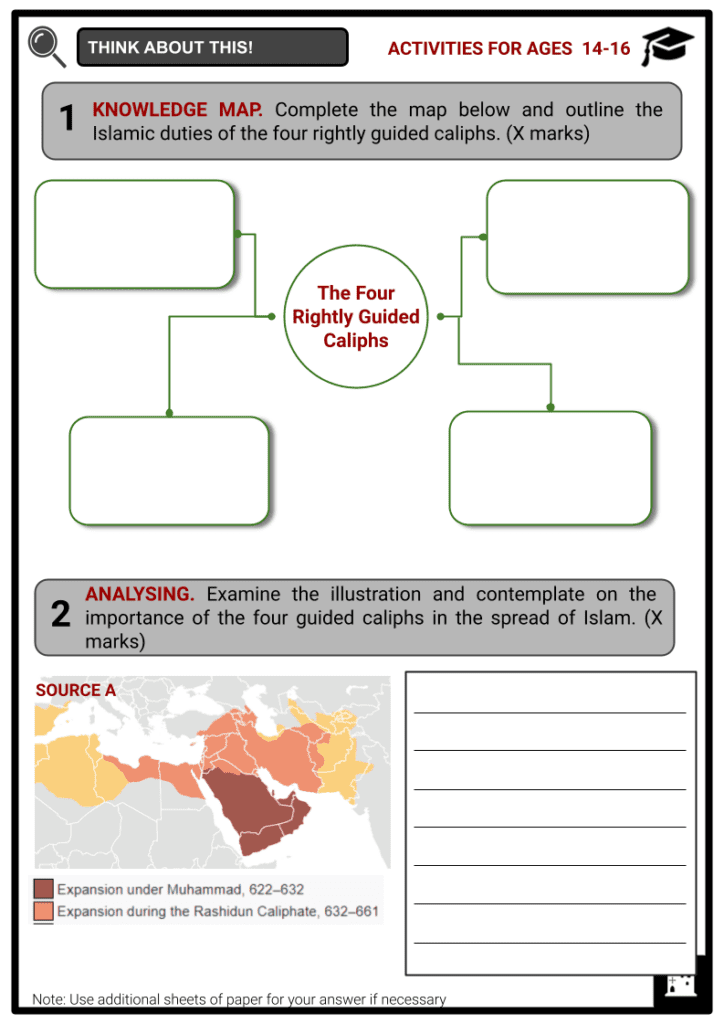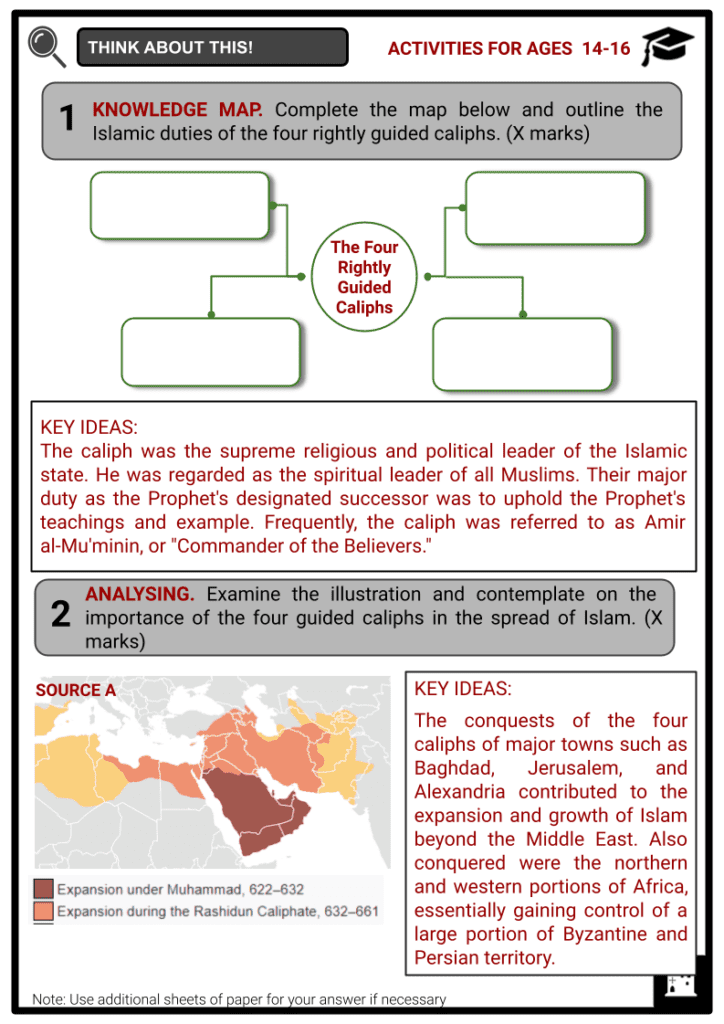Rightly Guided Caliphs Worksheets
Do you want to save dozens of hours in time? Get your evenings and weekends back? Be able to teach about Rightly Guided Caliphs to your students?
Our worksheet bundle includes a fact file and printable worksheets and student activities. Perfect for both the classroom and homeschooling!
Summary
- Background
- The First Four Caliphs
- Shia and Sunni Belief
Key Facts And Information
Let’s find out more about the Rightly Guided Caliphs!
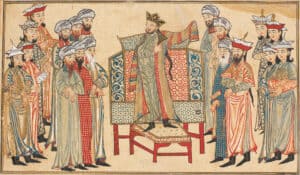 The Rightly Guided Caliphs, also known as the Rashidun Caliphs, are the first four successor and Islamic leaders following the Prophet Muhammad. These four caliphs were among the Prophet's closest companions and most ardent followers. The Muslims have agreed that the phrase "rightly guided" refers to Abu Bakr, Umar, Uthman, and Ali. After the Prophets, they are the best of the people. In Sunni Islam, the rule of these caliphs is regarded as a religious model to be imitated and obeyed. It was also the time when Islam expanded to all corners of the globe. The four guided caliphs were concerned about the preservation of Allah's faith and adherence to Muhammad's teachings.
The Rightly Guided Caliphs, also known as the Rashidun Caliphs, are the first four successor and Islamic leaders following the Prophet Muhammad. These four caliphs were among the Prophet's closest companions and most ardent followers. The Muslims have agreed that the phrase "rightly guided" refers to Abu Bakr, Umar, Uthman, and Ali. After the Prophets, they are the best of the people. In Sunni Islam, the rule of these caliphs is regarded as a religious model to be imitated and obeyed. It was also the time when Islam expanded to all corners of the globe. The four guided caliphs were concerned about the preservation of Allah's faith and adherence to Muhammad's teachings.
Background
- Muhammad ibn Abdullah (c. 570–8 June 632 CE) was an Arab religious and political figure who is regarded with founding the world religion of Islam. He was a prophet who preached and reaffirmed the monotheistic beliefs of Adam, Abraham, Moses, Jesus, and other prophets.
- Like that of God's past messengers, Prophet Muhammad's mission was to encourage people to worship and submit to the One True God. In essence, submitting to God is adhering to His commands as stated in the Holy Qur'an and as demonstrated by Sunnah (the practise of the Prophet).
- The Arabic word "Khalifa," which is short for Khalifatu Rasulil-lah, is translated as "Caliph" in English. The latter term denotes the Successor to the Holy Prophet Muhammad, the Messenger of God.
- The title "Khalifatu Rasulil-lah" was initially applied to Abu Bakr, who first succeeded the Prophet as the leader of the Muslim community.
- During the Middle Ages, the Islamic Empire was governed by a Muslim government known as the Caliphate. The Caliphate ruled over North Africa, Western Asia, and parts of Europe for a long time. Its culture and trade affected much of the civilised world, spreading Islam and advancing science, education, and technology.
- The Caliph was the leader of the Muslim community and his major duty as the Prophet's designated successor was to uphold the Prophet's teachings and example. Since the Prophet's death marked the completion of religion and the end of Divine revelation, it was up to the Caliph to ensure that all law was in conformity with the teachings of the Qur'an and the Sunnah.
- The Caliph was a ruler over Muslims, but he was not their sovereign, as God alone possesses such authority according to their beliefs. As long as the Caliph obeyed God, he was to be obeyed. He was responsible for establishing and sustaining conditions that made it easier for Muslims to live according to Islamic beliefs, as well as ensuring that everyone was treated fairly.
- Historians refer to the period under the rule of the Four Caliphs as the Rashidun Caliphate. From 632 to 661, the Rashidun Caliphate existed for 30 years. It was succeeded by the Caliphate of the Umayyads. The initial capital of the Caliphate was located in Medina.
The First Four Caliphs
- The first four caliphs ("successors") to rule the Muslim community after the passing of the Islamic prophet Muhammad were known as the Rashidun Caliphs, frequently known as the Rashidun or Rightly Guided Caliphs, because they all had their lessons in Islam from the Prophet Muhammad himself.
- During Islam's formative years, they were also Muhammad's closest companions and counsellors.
Abu Bakr's reign (632–634)
- The caliphate developed as a result of Muhammad's death in June 632 and the subsequent dispute over his leadership succession.
- Abu Bakr of the Banu Taym clan, a childhood friend and close comrade of Muhammad, was chosen the first caliph in Medina and launched the conquest of the Arabian Peninsula.
- Abu Bakr was Muhammad's father-in-law and an early convert to Islam. His nickname was "The Truthful." During his brief reign as caliph, Abu Bakr suppressed rebellions by several Arab tribes and established the Caliphate as the region's dominant power.
- Some tribes renounced Islam and rebelled under leaders who proclaimed themselves to be new prophets, but Abu Bakr crushed them in the Ridda war.
- The Ridda Wars were a military expeditions waged against rebellious Arabian tribes by the first Caliph Abu Bakr. They began immediately after Muhammad's death in 632 and ended the following year, with the Rashidun Caliphate victorious in all conflicts. These conflicts cemented the caliphate's hold over Arabia and reestablished its rising status.
- Abu Bakr launched the Islamic conquests of the Byzantine and Sasanian empires after uniting Arabia under Islam. It's not clear if one of his goals was a full-scale imperial invasion, but he did set in motion a path that, a few decades later, led to one of the biggest empires in history. Abu Bakr started with Iraq, the Sasanian Empire's most prosperous province.
- Under Abu Bakr's direction, the early stages of the compilation of the Qur'an were carried out.
Umar ibn al-Khattab’s reign (634–644)
- Before Umar passed away, he created a committee of six men to choose the new caliph and instructed them to select one of their own number. All of the males, including Umar, were from the Quraysh tribe. The "ibn" in the names mean "son of" in Arabic.
- The committee selected two candidates: Uthman and Ali. Ali belonged to the Banu Hashim clan (the same clan as Muhammad) of the Quraish tribe, was Muhammad's cousin and son-in-law, and was one of Muhammad's companions from the beginning of Muhammad's mission. Uthman was a member of the Quraysh clan Umayyad. He was Muhammad's second cousin and son-in-law, as well as an early convert to Islam. Uthman was selected in the end.
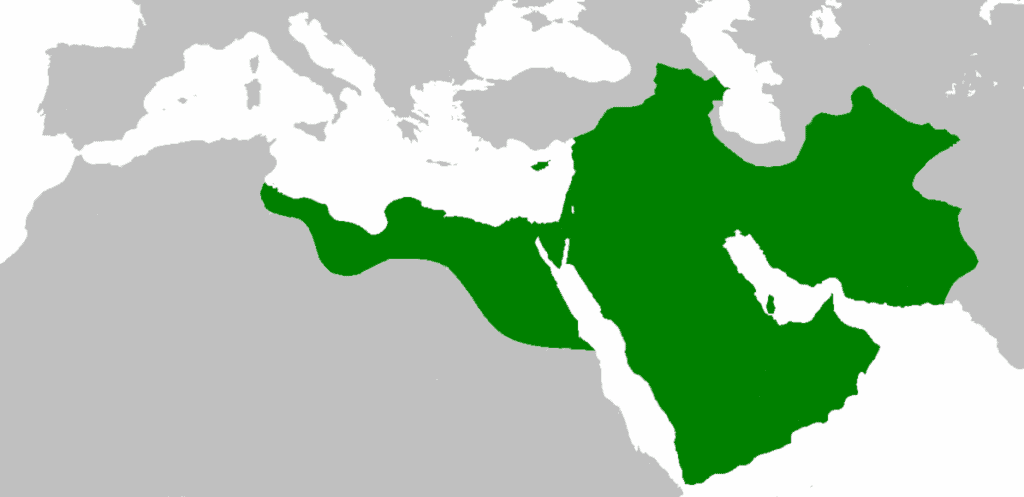
About the year 654, during the reign of Caliph Uthman, the Rashidun Caliphate saw its greatest expansion. - The title amir al-mu'minin ("Commander of the Faithful" or "Prince of the Believers) was first used by Umar upon his ascension and thereafter became the norm for caliphs.
- The new caliph resumed his predecessor's war of conquest by advancing further into the Sassanian Empire, north into Byzantine territory, and into Egypt. The long battle between the Byzantines and Persians had left both sides militarily tired, allowing the Islamic troops to defeat them with relative ease.
- By 640, they had taken all of Mesopotamia, Syria, and Palestine under the hands of the Rashidun Caliphate; by 642, they had invaded Egypt, and by 643, the entire Sassanian Empire.
- While the caliphate continued its rapid growth, Umar laid the groundwork for a cohesive political organisation. He established the Diwan, a government affairs agency. The military was placed directly under governmental control and paid by the government. Umar did not demand non-Muslim populations in conquered territories to convert to Islam, nor did he attempt to centralise administration.
- Instead, he permitted subject populations to retain their religion, language, and customs, and he left their administration largely unaltered, imposing merely a governor (amir) and a financial official known as an amil. These new positions were essential to the empire's taxing system's efficiency, which financed the empire.
- Umar is also credited with establishing the Islamic calendar, which is lunar like the Arabian calendar but has its foundation in 622, the year of the Hijra when Muhammad moved to Medina.
- In 644, as Umar was leading the morning prayers, the Persian
slave Abu Lu'lu'a Firuz assassinated him.
Uthman ibn Affan's reign (644–656)
- Uthman ruled as caliph for twelve years. Like the other Four Caliphs, Uthman was the Prophet Muhammad's closest companion.
- During the initial part of his reign, he was the most popular caliph among all Rashiduns, however he faced increasing resistance in the second half.
- The ultimate compilation of the Qur'an was Uthman's most significant accomplishment. Under his direction, diacritics were inscribed with Arabic letters so that non-native Arabic speakers may read the Qur'an with ease.
- Uthman chose to negotiate a peaceful resolution instead of taking military action after a demonstration grew into a siege on his home in an effort to prevent a Muslim civil war.
- After the negotiations, the protestors went back but discovered a man had followed them and had given them the go-ahead to be put to death.
- At that time, the protesters went back to Uthman's house with the go-ahead. Uthman stated he did not write the directive and tried to reason with the demonstrators. In response, the demonstrators demanded that he relinquish his caliphate.
- Uthman declined and went back to his chamber. When he was reading the Qur'an there, the demonstrators burst into his home and killed him.
Ali ibn Abi Talib's reign (656–661)
- Ali ibn Abi Talib served as the fourth caliph. Ali was the son-in-law and cousin of Muhammad. He was wed to Fatimah, the youngest daughter of Muhammad. Many people believe that he was the first man to convert to Islam.
- Ali was regarded as a wise leader who produced a large number of speeches and proverbs.
- After being appointed caliph, Ali moved the capital from Medina to Kufa, the Muslim garrison city in present-day Iraq. Ali also sacked the majority of Uthman's corrupt governors.
- He was murdered while performing prayer in Kufa's Great Mosque.
Sunni and Shia Belief
- The divisions between Sunni and Shia Muslims are rooted in a dispute about Muhammad's succession and have since taken on political, religious, and legal dimensions.
- For contemporary Islamic discussions, the first four caliphs are especially important because, while the first three of the four were usurpers for Shia Muslims, the Sunnis viewed them as examples of just governance.
- Conflicts and difficulties between the four rightly guided caliphs are described in accepted traditions of both Sunni and Shia Muslims.

The calligraphic depiction of Sunni Islamic holy figures, including Muhammad, Abu Bakr, Umar, Uthman, Ali, Hasan ibn Ali, and Husayn ibn Ali, as well as Allah (God).
Sunni View
- The attribution of the name 'rightly-guided' to the early caliphs in Sunni Islam implies their standing as religious role models whose actions and beliefs should be followed and imitated. In this sense, they are both rightly-guiding and rightly-guided. The religious accounts of their lives serve as a guide to correct belief.
- They were all Muhammad's close companions and relatives: Aisha and Hafsa, the daughters of Abu Bakr and Umar, were married to Muhammad, while Ruqayyah and Umm Kulthum, two of Muhammad's daughters, were married to Uthman and Fatimah to Ali.
- Similarly, their succession was not inherited, a practise that would become the norm beginning with the future Umayyad Caliphate. Originally, the decision of the council or the caliph determined the successor.
- The Sunni have always seen the reign of the Rashidun as exemplifying a system of Islamic purity and merit-based government that they aspire to imitate.
- The Sunni also link this system with the worldly success promised by Allah in the Qur'an and Sunnah to Muslims who sought His pleasure; this exceptional achievement has added to the attraction of the Rashidun period.
Shia View
- Similar to other prophets mentioned in the Qur'an, the Shia believe that Muhammad's succession was determined by divine appointment rather than by consensus. As with previous prophets in the Qur'an, according to the Shia, God chose Muhammad's successor from his family.
- In particular, Muhammad designated Ali, his cousin and son-in-law, as his rightful successor at the Ghadir Khumm event and on other occasions before his death.
- In Shia belief, direct revelation ceased with Muhammad's death, but Ali remained God's righteous leader or Imam, comparable to the successors of the previous prophets mentioned in the Qur'an.
- Ali received Muhammad's divine wisdom and authority to accurately interpret the Qur'an, notably its allegorical and metaphorical verses, after Muhammad's death.
- According to the Shia belief system, since Adam was the first prophet, the earth has always had an Imam in the form of prophets and their divinely chosen successors. The Imamate was also transferred by divine inspiration from Ali to the following Imam, Hasan.

